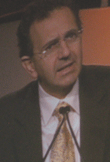Regenerative Medicine, Tissue Engineering, and Stem Cells: New Health Care Approaches for the 21st Century
Stem cells offer real solutions for those who often have no better options, according to one of the country's leading researchers in tissue engineering and regenerative medicine.

Stem cells offer real solutions for those who often have no better options, according to one of thecountry's leading researchers in tissue engineering and regenerative medicine.
Anthony Atala, MD, Director of the Institute for Regenerative Medicine at Wake Forest University, presented an overview of research into stem cell therapies to the opening plenary audience at the AAP's NationalConference and Exhibition.
While Atlas's experience with tissue engineering and regenerative medicine was substantial, he cededcredit to many colleagues over the years. For almost two decades, over 600 people have worked toadvance the cause of stem cell use in medicine. Its results spoke for themselves, via Dr.Atala.
Traditional methods for building an organ, say in a patients with spina bifida and animperfect bladder, involves a synthetic "scaffold" implanted inside the body. A cell-seeded scaffold,Dr. Atala showed in elaborate details, measurably involves both initial healing and six-monthfollow-up results.
For numerous tests of effectiveness -- including molecular markers, collagen impositions,tensile stress and strain, neurofilamint, protein innovation, and organ bath studies -- cell-seededscaffolds for bladders, uteruses, and urethras showed an advantage over the scaffolds alone.
A range of organs can be duplicated using the stem cells that are essential in creating thecell seeding. The pancreas cannot be, as of yet, but most other body elements -- bone, skin, heart, muscle, and most internal organs -- can.
The stem cells grow amazingly fast. A clump the size of a ripped-in-half stamp will, after 60 days, be large enough to cover a football field. The cell seeding of which Dr. Atala spoke were done during a 15-day incubation period. One thing the cells won't do, it seems, is form teratomas. Even when implanted into metastatic growths, the cells refused to grow into tumors.
One worry about using stem cells was if maternal mitochondria would cause rejection of thetissue by the host body. Experiments in cows to create renal cells showed, at the six-month endmark,a clump of cells that produced a yellow liquid. Multiple tests confirmed it to be identical to urine.Maternal mitochondria is now not considered a problem.
The biggest challenge for the future is inventory. "The egg supply is a problem," Dr. Atalasaid, with understatement. More eggs would lead to a greater variety of stem cells, and thus agreater possibility of repairs for inborn conditions.